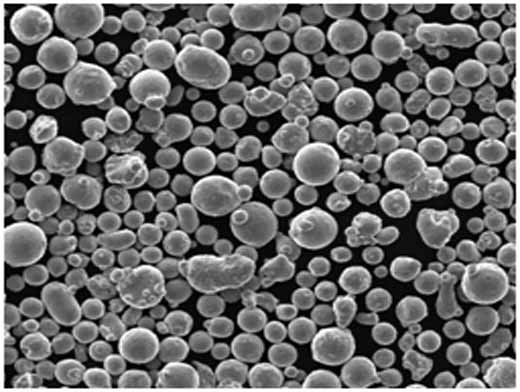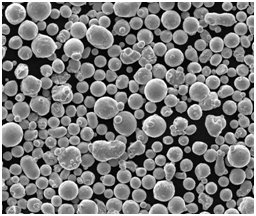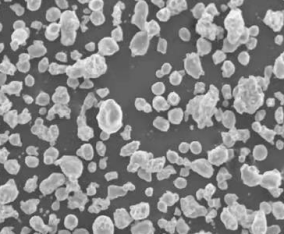Visión general de CuSnZn Polvo
El polvo CuSnZn, también conocido como polvo de cobre-estaño-zinc, es una aleación en polvo especializada que ofrece una combinación única de propiedades mecánicas, resistencia a la corrosión y versatilidad en diversas aplicaciones industriales. Esta aleación se compone normalmente de una mezcla equilibrada de cobre (Cu), estaño (Sn) y zinc (Zn), que trabajan en sinergia para mejorar las propiedades del polvo para usos en metalurgia, revestimientos, sinterización y soldadura fuerte.
La aleación CuSnZn destaca en la categoría de polvos metálicos por su equilibrio entre fuerza y resistencia a la corrosión, lo que la hace popular en industrias que van desde la automoción y la aeroespacial hasta la electrónica y la construcción. Con la adición de estaño, la aleación gana en resistencia y tenacidad, mientras que el zinc introduce una mayor resistencia al desgaste y cualidades anticorrosivas.
Profundicemos en los tipos, composición, características y aplicaciones del polvo de CuSnZn. También examinaremos modelos específicos, especificaciones y comparaciones para ayudarle a comprender dónde puede encajar esta aleación en polvo en sus proyectos.

Composición y propiedades del polvo de CuSnZn
La composición del polvo CuSnZn varía ligeramente en función de las características deseadas, pero los componentes básicos siguen siendo el cobre, el estaño y el zinc en proporciones variadas. Cada metal aporta propiedades únicas a la aleación:
| Componente | Símbolo | Gama de composición típica (%) | Propiedades aportadas |
|---|---|---|---|
| Cobre | Cu | 60-90% | Alta conductividad térmica/eléctrica, ductilidad |
| Estaño | Sn | 5-20% | Resistencia, dureza, resistencia a la corrosión |
| Zinc | Zn | 5-20% | Resistencia al desgaste, mayor resistencia, punto de fusión más bajo |
Comprender el papel de cada componente
- Cobre (Cu): El metal primario, el cobre, proporciona una ductilidad esencial, haciendo que el polvo sea fácil de moldear y formar. Su alta conductividad eléctrica también lo hace favorable para aplicaciones electrónicas.
- Estaño (Sn): La adición de estaño refuerza la aleación, mejora la dureza y aumenta la resistencia a la corrosión, por lo que es ideal para piezas mecánicas.
- Zinc (Zn): El zinc añade resistencia al desgaste y contribuye a reducir el punto de fusión, lo que resulta ventajoso en aplicaciones como la soldadura fuerte y la soldadura blanda.
Características del polvo de CuSnZn
La mezcla única de CuSnZn en polvo da lugar a las siguientes características notables:
| Característica | Detalles |
|---|---|
| Resistencia a la corrosión | Alta resistencia a la corrosión en diversos entornos gracias a su contenido en cobre y estaño. |
| Fuerza | La aleación es resistente y duradera, por lo que resulta ideal para aplicaciones estructurales y mecánicas. |
| Resistencia al desgaste | El zinc mejora la resistencia al desgaste, adecuado para componentes sometidos a grandes esfuerzos. |
| Conductividad térmica | Alta conductividad térmica gracias al cobre, útil en aplicaciones sensibles al calor. |
| Punto de fusión bajo | Punto de fusión más bajo que el del cobre puro, lo que permite una mejor soldadura fuerte y sinterización. |
Tipos y grados de CuSnZn Polvo
He aquí algunos de los tipos más comunes y modelos específicos de polvo de CuSnZn, cada uno optimizado para necesidades industriales particulares. Estos polvos varían en cuanto a tamaño de partícula, composición y aplicación.
| Nombre del modelo | Composición (Cu-Sn-Zn %) | Solicitud | Propiedades únicas |
|---|---|---|---|
| CuSn10Zn2 | 88-10-2 | Revestimientos decorativos, joyería | Excelente resistencia a la corrosión |
| CuSn5Zn5 | 90-5-5 | Contactos eléctricos, revestimientos de baja fricción | Alta conductividad eléctrica |
| CuSn8Zn4 | 88-8-4 | Cojinetes, casquillos | Mayor resistencia al desgaste |
| CuSn6Zn3 | 91-6-3 | Engranajes, piezas de pequeña maquinaria | Resistencia y maquinabilidad equilibradas |
| CuSn9Zn1 | 90-9-1 | Soldadura fuerte y blanda | Punto de fusión más bajo |
| CuSn7Zn2 | 91-7-2 | Componentes aeroespaciales, intercambiadores de calor | Alta conductividad térmica |
| CuSn12Zn1 | 87-12-1 | Componentes de automoción, elementos de fijación | Mayor resistencia |
| CuSn3Zn5 | 92-3-5 | Accesorios industriales, asientos de válvulas | Buena resistencia al desgaste abrasivo |
| CuSn11Zn4 | 85-11-4 | Equipos marinos, hélices | Resistencia superior a la corrosión en el agua |
| CuSn15Zn2 | 83-15-2 | Piezas mecánicas sometidas a grandes esfuerzos | Gran dureza y resistencia a la tracción |
Cada uno de estos modelos ofrece puntos fuertes ligeramente diferentes, por lo que es crucial elegir el tipo adecuado para las necesidades específicas.









Aplicaciones del polvo de CuSnZn
La versatilidad del polvo de CuSnZn lo hace adecuado para una amplia gama de aplicaciones:
| Solicitud | Detalles |
|---|---|
| Industria del automóvil | Rodamientos, bujes, engranajes, por su resistencia al desgaste y durabilidad. |
| Industria aeroespacial | Componentes de motores y piezas estructurales que requieren una gran solidez y resistencia a la corrosión. |
| Electrónica | Contactos eléctricos, conectores y materiales de disipación térmica. |
| Ingeniería naval | Hélices, accesorios marinos, debido a su mayor resistencia a la corrosión. |
| Fabricación industrial | Rodamientos, bujes, revestimientos de baja fricción para maquinaria. |
| Joyería y artes decorativas | Se utiliza para revestimientos estéticos, joyería debido a su atractivo color y durabilidad. |
| Soldadura fuerte y blanda | Aleaciones de bajo punto de fusión que proporcionan una fuerte unión en las uniones metálicas. |
| Intercambiadores de calor | Una alta conductividad térmica es beneficiosa para una transferencia de calor eficaz. |
Especificaciones de los modelos de polvo de CuSnZn
| Modelo | Gama de tamaños de partículas (µm) | Densidad (g/cm³) | Punto de fusión (°C) | Dureza (HV) |
|---|---|---|---|---|
| CuSn10Zn2 | 20-45 | 7.6 | 980 | 120 |
| CuSn5Zn5 | 15-50 | 7.7 | 990 | 110 |
| CuSn8Zn4 | 25-60 | 7.5 | 970 | 130 |
| CuSn6Zn3 | 10-40 | 7.65 | 980 | 125 |
| CuSn9Zn1 | 5-30 | 7.8 | 950 | 115 |
| CuSn7Zn2 | 20-60 | 7.7 | 960 | 130 |
| CuSn12Zn1 | 15-45 | 7.6 | 940 | 140 |
| CuSn3Zn5 | 20-55 | 7.75 | 930 | 110 |
| CuSn11Zn4 | 25-70 | 7.6 | 920 | 135 |
| CuSn15Zn2 | 10-50 | 7.5 | 910 | 145 |
Ventajas y limitaciones de CuSnZn Polvo
| Característica | Ventajas | Limitaciones |
|---|---|---|
| Resistencia a la corrosión | Gran resistencia a la corrosión en entornos marinos e industriales. | Menos resistente que otras aleaciones en condiciones de acidez extrema. |
| Resistencia al desgaste | Excelente resistencia al desgaste, especialmente con zinc añadido. | Un mayor contenido de zinc puede provocar fragilidad en algunas aplicaciones. |
| Conductividad térmica | Eficaz en la transferencia de calor, útil para la electrónica y los intercambiadores de calor. | No tan alto como el cobre puro o las aleaciones de cobre-aluminio en aplicaciones térmicas. |
| Resistencia y dureza | Proporciona un buen equilibrio entre resistencia y dureza, ideal para piezas portantes. | Pueden ser más blandas que las aleaciones de acero, lo que limita su uso en aplicaciones sometidas a grandes esfuerzos. |
| Maquinabilidad | Fácilmente mecanizable con herramientas estándar, lo que reduce los costes de producción. | Un mayor contenido de estaño o zinc puede reducir la maquinabilidad debido a una mayor fragilidad. |
| Coste | Suele ser más asequible que el cobre puro o las aleaciones especializadas. | Los precios fluctúan en función de la demanda de cobre, estaño y zinc. |
Principales proveedores e información sobre precios
| Proveedor | País | Precio medio (por kg) | Grados disponibles |
|---|---|---|---|
| ABC Metales | EE.UU. | $25 – $40 | CuSn10Zn2, CuSn5Zn5 |
| Global Alloy Ltd. | Alemania | $28 – $45 | CuSn8Zn4, CuSn6Zn3 |
| Mundo de aleación | Japón | $30 – $42 | CuSn7Zn2, CuSn12Zn1 |
| Metales R Us | REINO UNIDO | $27 – $38 | CuSn3Zn5, CuSn11Zn4 |
| CopperCraft | China | $20 – $35 | CuSn9Zn1, CuSn15Zn2 |

Preguntas más frecuentes
| Pregunta | Respuesta |
|---|---|
| ¿Para qué se utiliza el polvo de CuSnZn? | Se utiliza mucho en la industria automovilística, aeroespacial, naval y electrónica por su resistencia a la corrosión. |
| ¿Puede el polvo de CuSnZn sustituir al cobre puro? | En muchos casos, sí. Ofrece una conductividad térmica similar, pero con mayor solidez y resistencia a la corrosión. |
| ¿Cuál es el rango de precios típico? | Los precios varían entre $20 - $45 por kg, según la composición y el proveedor. |
| ¿Es bueno el polvo de CuSnZn para la soldadura fuerte? | Por supuesto, su bajo punto de fusión lo convierte en una excelente opción para aplicaciones de soldadura fuerte y blanda. |
| ¿Cuál es la principal ventaja de esta aleación? | La aleación ofrece una combinación equilibrada de fuerza, resistencia al desgaste y resistencia a la corrosión. |

